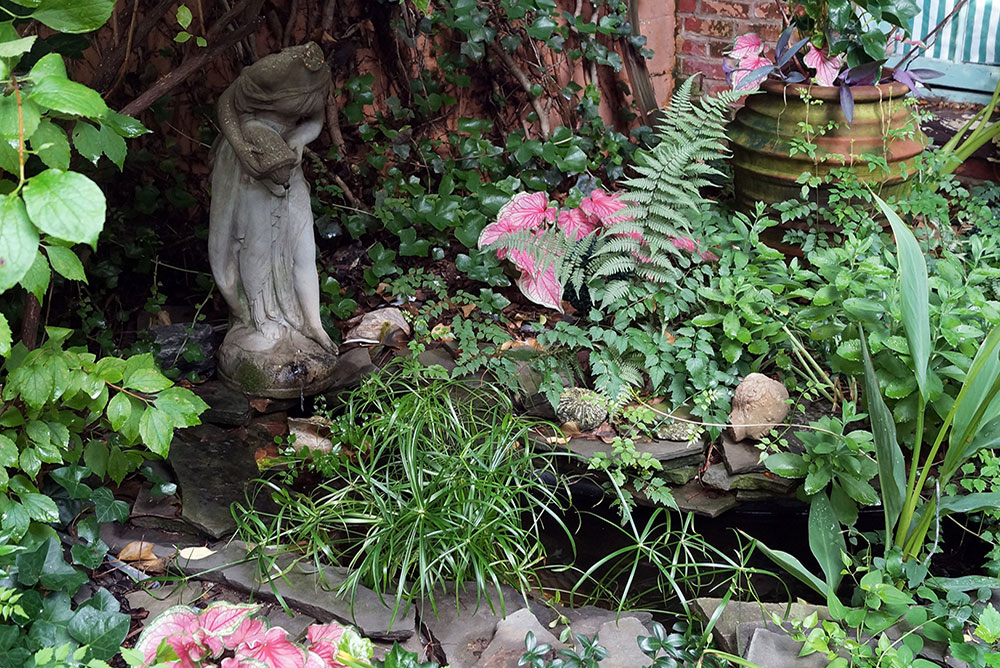
The backyard pond that’s the scene of the crime. But it’s unclear who the perpetrator is. Rocky? / Photo by Stephanie Cavanaugh.
THE FISH are dropping like flies.
Ah, my poor Prince. These are his pets. Last summer there were a dozen in our little
pond, a few weeks ago we counted eight, now there are just three. He is in mourning,
listlessly lifting rocks to see if one or another is just hiding, sighing as he fidgets with the filter. It is very sad.
This is despite his protective, if extremely unattractive, maneuvers. There’s the green milk carton with the little holes the fish can dart into if threatened. There’s a rock on top to hold it down. The pond itself is usually topped with a screen door anchored with more rocks.
A pond is supposed to be an attractive garden spot, isn’t it? A place to sit beside with your jug of wine and contemplate nature—not to sit imagining life in a gulag.
These are not expensive specimens; feeder fish, they’re called. They’re not even given the dubiously grander title of Goldfish, though most are gold, and they are definitely fish. They are usually purchased as treats for your anaconda, not as prized pond denizens.
When the pond was first planted in the garden, we installed koi. They were perky and fat, and then fatter, then pffft. Talk about heartbreak. Koi are expensive!
This being years ago, I walk my fingers around the Internet to get current koi pricing
which will be more than we paid, but figure in inflation and you’ll get the idea.
I find, at Koi.com , a 2-year-old, 22-inch-long G Mako Kohaku. This is a silvery specimen with a wide, squiggly orange ribbon running from tail to head. When anything is said to be “boarding in Japan,” you know you’re in for sticker shock. One fish, $10,000. Slightly more reasonable, a Tancho Sanke with an orange circle on its forehead resembling the Japanese flag. The 29½-inch-long fish is $8,400. If I wished to do the math it would be . . . something per inch, wouldn’t it?
These are not like the fish we bought. Not only because one of them would take up most of the pond.
More like it is a $140 quintet of five- to six-inch Blue Ridge Koi offered on Amazon. Live arrival is guaranteed and shipping is, of course, free with that handy Amazon
membership. Still, that’s a hefty tab for raccoon food, as it is Rocky that we suspect is
nibbling the fish.
An interesting (to me) aside is that several in the photo of these Blue Ridge fish have
stripes and dots that are quite similar to those on their pricy Japanese cousins. In fact,
suspiciously similar in appearance to our feeder fish, which were 12 for a buck last
year at Petco. Maybe they’re $1.10 this year, big deal.
The British edition of Country Living magazine currently has a lovely article on ponds, from splashy affairs for your manor house to “pocket ponds,” the size of a “washing-up bowl” that encourage newts and frogs and damselflies to frolic among your irises and such.
In our case that would be the mosquitos and raccoons.
Perhaps it is unfair to blame the raccoon, but I know it’s not mosquitos. Whatever it is, this killer hunts with stealth by night. The fish are apparently gobbled whole. There are no little fishy bits floating about, just one goes missing, then another.
There are no screams.
—Stephanie Cavanaugh
LittleBird “Stephanie Gardens” reports here weekly about life in her busy backyard.

Your raccoon and our raccoon seem to be in cahoots!!!